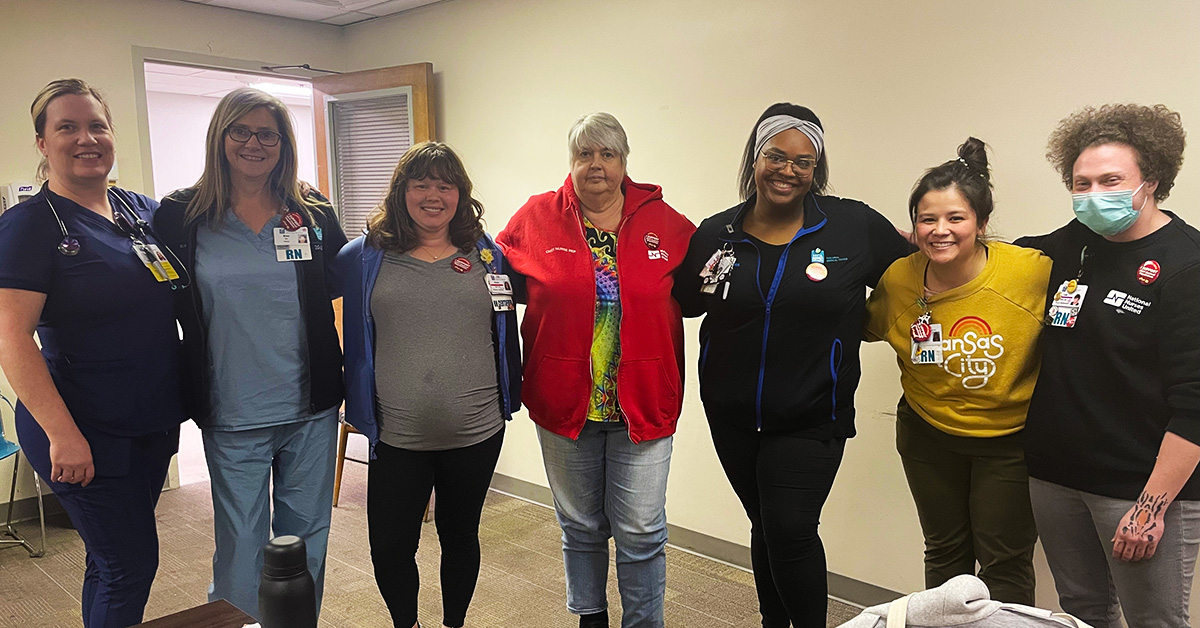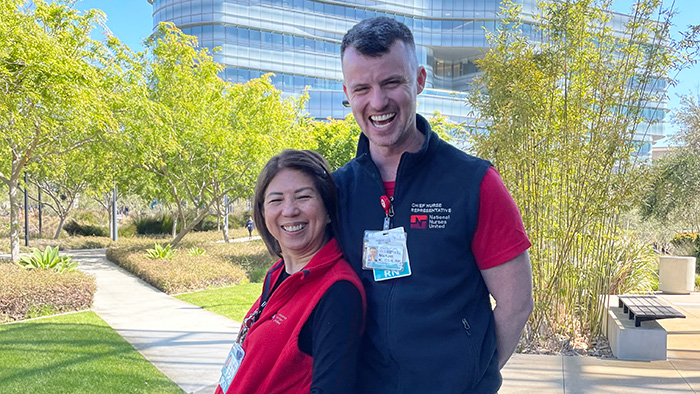Where the Action Is

Professional Practice Committee meetings are where nurses brainstorm solutions and hold management accountable
By Chuleenan Svetvilas
National Nurse magazine - April | May | June 2024 Issue
The professional practice committee (PPC) meeting is where the action is. If you want to find out what is happening at your hospital, talk to a PPC member.
“It’s where we discuss all issues that affect our ability to provide safe patient care to our patients such as nursing practice, safety, and staffing, among others,” said Dahlia Tayag, RN, PPC member at the University of California, San Diego Medical Center (UCSD) and chief nurse representative at the Hillcrest campus. “It’s where we brainstorm possible solutions and provide recommendations to hospital leadership.”
The PPC is a direct-care, RN-controlled committee in every contract negotiated by California Nurses Association/National Nurses Organizing Committee (CNA/NNOC), with the authority to document unsafe practices and the power to make real changes at the facility by making recommendations to nursing administration. (For more about the PPC, see the January-February-March 2024 issue to read the first article in this new series.)
How often the PPC meets depends on the collective bargaining agreement. At UCSD, where CNA represents more than 4,300 nurses, the 20-member PPC meets monthly, with management attending once a quarter for about one-and-a-half hours. In Chicago, at John H. Stroger, Jr. Hospital of Cook County, the PPC meets with the chief nursing officer (CNO) and other management every month during part of each PPC meeting. NNOC represents about 800 nurses at Stroger Hospital, which has 10 elected PPC members.
At Research Medical Center in Kansas City, Mo., where NNOC represents more than 560 RNs, the eight-member PPC meets monthly for four hours of paid time and usually invites management once a quarter to meet for 30 minutes of the PPC meeting. But they can schedule additional meetings with management as needed.
“The PPC is run by nurses for nurses,” said Cheryl Rodarmel, RN, chief nurse rep and chair of the PPC at Research Medical. “At our meetings, we collect ADOs [assignment despite objection forms], we look at equipment needs, nursing practice, and assignments that create unsafe assignments. We also look at educational needs for nurses.”
The PPC Agenda
So what exactly occurs in a PPC meeting? If it’s only nurses meeting, no management, what typically happens is a discussion of ongoing issues and new issues, current campaigns, and recommendations to management. At UCSD, where all PPC members are also nurse reps, the PPC meeting is held in the afternoon of the second Thursday of every month. The two chief nurse reps and the PPC chair review the agenda before it goes out to the PPC in advance of the meeting.
The UCSD nurse reps meet in the morning of that second Thursday, starting at 7 a.m. When their meeting is over at 11 a.m. the reps/PPC members round the units and take a break for lunch, where they usually set up a table with updates and resources for nurses who want to drop by and find out what’s happening. The PPC meets in the afternoon, spending time summarizing what happened at the last PPC meeting, including what issues have been addressed, whether any issues discussed with management have been resolved, and who will be assigned to work on the ongoing issues.
Sometimes the PPC at UCSD breaks out into small groups of three to four members to discuss the issues each department is facing and make recommendations. “For example, this unit needs an extra nurse aid and needs to extend the resource nurse hours,” said Michael Kennedy, RN, PPC member for the ICUs at UCSD and chief nurse rep for the La Jolla campus at UCSD. “Then when it comes time to meet with management, we have our priorities straight.”
When the breakouts are over, they report their discussion to the entire PPC and together they make plans for the next steps. “If we have many urgent issues to address, we meet as a group and do not have any breakouts,” said Tayag, who has been a nurse rep and PPC member for the post-anesthesia care unit since 2008.
At Research Medical Center, the PPC meets on the first Thursday of the month from 3 p.m. to 7 p.m. All of the PPC members are also nurse reps. Their meetings generally follow the same format, with the first half of the meeting involved with taking attendance, rounding via text to all union leadership and then rounding to all the break rooms. The PPC members then pair off to do in-person rounding, updating each union bulletin board by removing out-of-date info and posting the most recent PPC meeting minutes and recommendations as well as the latest ADO report. They also pick up any new ADOs and talk to nurses on break about their concerns.
When rounding is done, the PPC goes over “old business,” issues that they are still working on, and then they tackle “new business” and write recommendations to the CNO. The last hour of the meeting, PPC members go over the ADOs they collected during rounding and fill out the ADO report forms. Then they make recommendations for improving or fixing issues. Rodarmel, who has worked at Research for 31 years, including 13 years as an RN, uses those recommendations to write the PPC minutes that get submitted to the CNO for her responses.
The staffing committee, comprising four PPC members and an observer, meets quarterly for an hour before the PPC meeting starts, and reports their findings to the PPC.

Meeting with Management
UCSD’s PPC meets every three months with UC management for one-and-a-half hours. “Before we meet with management, we prioritize what we want to discuss with the CNO,” said Kennedy, who has worked in the neuro ICU for seven years. “We have to decide which issues are the most pressing because we will only get to maybe four or five of them.”
Once that list of issues is prioritized, PPC members talk to people who are affected by each issue and come up with a strategy to discuss them with management. “If it’s a new and pressing issue, we will bring in nurses to talk about the issue,” said Kennedy, who has been an RN since 2009.
A week before the meeting with management, UCSD’s PPC sends out the agenda. The CNO is required to attend per the collective bargaining agreement, and she will invite the appropriate directors to attend as well. For example, if there are security issues, she will invite the directors of security. “The point is a show of solidarity,” said Kennedy, who notes that the directors are not required to attend.
For the first hour, the PPC discusses the agenda and assigns speakers who are usually the rep from the department where issues are occurring. Then management arrives. Once management leaves, the PPC spends the last 30 minutes summarizing and discussing the meeting.
“We had our meeting with management in March and at our April PPC meeting we discussed four emerging issues: east campus staffing, telemetry training and ventilator patients on IMUs, and NP layoffs,” said Kennedy. “We discussed recommendations and fight-back strategies. Next month it could be new issues or the same issues, it just depends on how things develop. Then in June we will meet with the CNO, give our recommendations on new issues and follow up on past recommendations.”
At Research Medical Center, the current CNO has been sending a designee to attend PPC meetings. “Sometimes we are just sharing information,” said Rodarmel who has been a PPC member since 2011 and chair since 2014. “Sometimes the CNO’s designee will say they need to talk to the CNO before they can answer our questions.”
The PPC has called for additional meetings with management when there are urgent issues to be addressed. “For example, we have charge nurses on our orthopedic and nephrology units (who at this facility are not part of the bargaining unit) who will assign nurses to care for patients in units that are not in close proximity to the rest of their patients, which makes it an unsafe assignment,” said Rodarmel, who has worked at Research Medical Center for 31 years, including 13 years as an RN. “Our recommendation was that the charge nurses needed to be trained on how to make appropriate safe assignments, even if that resulted in moving patients to cluster them closer together. We now have a dispute resolution meeting with CNO about it.”
Meaningful Meetings
Regular meetings are the key to a strong PPC. “The PPC is where we confront nurse leadership with problems that nurses bring to our attention,” said Kennedy. “We are able to bypass the chain of command and escalate directly to the top, make recommendations, and hold leadership accountable.”
“The PPC is how we get nurses involved,” said Kennedy. “Some are afraid to let their managers know about problems. People feel empowered just by being in the room. Surrounded by nurses in the PPC, they will talk and say things they never would have said during rounds.
Rodarmel agrees. “You can use the PPC to expedite issues quickly, to organize internal actions, get out information to your members quickly,” said Rodarmel. “The more nurses realize what the PPC is, the better they can utilize that resource. It gives nurses a monthly voice directly to the CNO and holds them accountable through their responses.”
When Tayag first got involved with the PPC, some nurses were afraid to speak up for fear of retaliation. But as Tayag noted, “If you speak up for nurses and patients, you have protection as a union nurse and the support of our PPC leaders.”
“I have a big mouth,” said Tayag who has been a PPC member for 16 years. “I was told by my father that you fight for the people who cannot fight. Stand up. That’s why I first got involved as a nurse rep for my unit and with the PPC.”
Chuleenan Svetvilas is a communications specialist at National Nurses United.